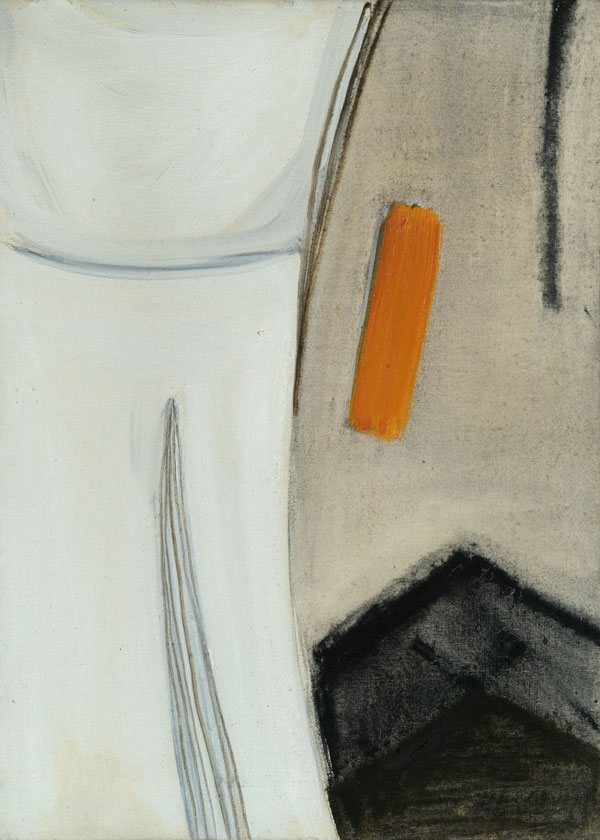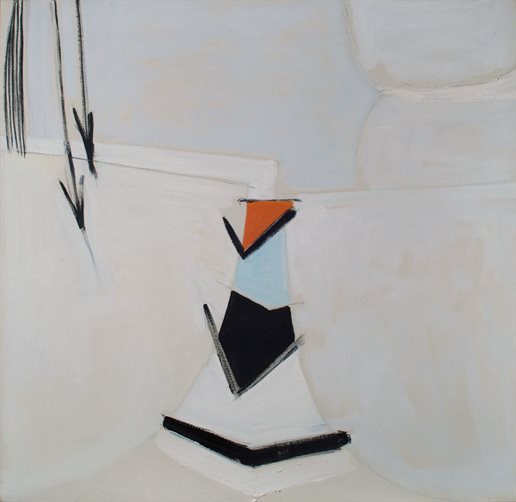This article explores the place of Terry Frost’s painting Madrigal (Leamington Spa Art Gallery and Museum) in his career, and its relation to abstract painting elsewhere in post-war Britain and beyond.
Matthew RampleyCollection: Leamington Spa Art Gallery and Museum
Keywords: Terry Frost, abstract, modernism, post-war, British

Fig.1 Terry Frost, Madrigal (1949), oil on canvas, 71 x 91 cm. Reproduced courtesy of Leamington Spa Art Gallery and Museum © BY KIND PERMISSION OF THE ESTATE OF TERRY FROST
Madrigal (fig.1) is one of three paintings by Terry Frost in the collections of Leamington Spa Art Gallery and Museum, the other two being Orange Umber (1960) (fig.2) and Orange and Blue (1963) (fig.3). Frost (1915–2003) was one of the most prominent painters and printmakers working in post-war Britain, and his work was typified by his use of large juxtaposed blocks of colour, sometimes in harmonious arrangements but sometimes, too, in awkward contrasts that created various effects of tension. Frost was a leading representative of the generation of British abstract painters who came to artistic maturity in the 1960s and were associated with the artists’ colony in St. Ives, including Patrick Heron (1920–99), Peter Lanyon (1918–1964) and Roger Hilton (1911–75).
Frost was a latecomer to art. Born in Leamington Spa, he attended occasional art classes as a teenager, but it was not until he was in his late 20s and a prisoner-of-war in Germany that he took to it more seriously, influenced by his fellow prisoner, the painter Adrian Heath (1920–1992). After the Second World War he studied in St. Ives and then in London at Camberwell School of Art, under William Coldstream (1907–87) and Victor Pasmore (1908–1998). These two painters could not have been more different. Coldstream devised a mode of precise realist figurative painting, which, with a stripped down and minimally expressive style, focused on urban interiors and sought to communicate a social reality that would make art relevant and accessible to non-specialists often baffled by the experiments of the avant-garde. Pasmore, in contrast, embraced the avant-garde language of abstraction [1].
The earliest surviving paintings by Frost indicate that initially he was closer to Coldstream, adopting the muted palette of his teacher, although in other respects the early Frost had not yet landed on a distinctive artistic language. Madrigal, a summer project set while he was still a student at Camberwell, marked an important turn. It was no longer merely quoting ideas and motifs from others, a criticism that could be levelled at his previous works; more importantly, it signalled his decision to emerge from under the shadow of Coldstream and to explore the possibilities of abstract painting.
Madrigal represents Frost’s decision to follow the model of Pasmore rather than keep to Coldstream’s peculiarly British figurative painting (since referred to as the Euston Road School of painting). The title was based on the 1935 poem ‘O lurcher-loving collier,’ by W. H. Auden, originally published as ‘A Madrigal’ [2]. Frost’s painting was, as he stated, an ‘intuitive reaction to the poem’ [3]. The poem alludes to moments of love stolen from the routine of coal labour, although there is also a suggestion, in the line ‘Your lamp is out, the cages all are still,’ that the miner of the poem has already died, raising the possibility that the poem is also a lament for the love lost due to his passing.
For Frost the poem evoked the landscape of the mining industry; its slagheaps and mining towers have been represented as diamonds and rectilinear square blocks, the sky in the upper centre of the picture rendered in a dirty grey. The dark palette of the picture makes for a bleak and sombre image, and it is all the more striking when compared with the later paintings in Leamington Spa Art Gallery and Museum, which bear the much lighter tones for which he is better known, often with bright primary colours. Madrigal’s red blocks of colour might seem out of place, but they suggest, perhaps, coal-fired furnaces.
Given its subject matter and gloomy palette, the painting still owes something to the ‘kitchen-sink’ realism of Coldstream, but already Frost was moving in a different direction. We can gain an indication of this when we read of his account of viewing Rubens’s Judgement of Paris (1632–5) in the National Gallery at around the same time:
I looked at the painting and the painting had to stand and fall by the painting. Now this is nothing to do with the story; the thing that fascinated me about the painting was that you’ve got the same figure used three times, side, back and front, so it makes a D-shaped turn. Three reds, one in the tree, one on the central model, one on Paris; eye-glance to make a space: there is so much going on in that painting. The same things go in “modern art” [4].
This is a famous painting and a well-known myth, but it is notable that rather than focusing on the topics traditionally associated with Rubens’s work, such as its interpretation of the mythological subject matter, or Rubens’s treatment of the human – particularly the female-body, Frost chose to concentrate on the composition and structure conveyed by the placement of the drapery. In other words, Frost was viewing the painting in primarily formal terms, and this explains, too, the apparently tautological statement at the beginning: ‘the painting had to stand and fall by the painting.’ Frost’s comment on Rubens, as well as his execution of Madrigal and the works that he produced thereafter (including those in the Leamington Spa collection), signified his move into the exploration of formal pictorial qualities that was the hallmark of post-war abstraction.

Fig.2 Terry Frost, Orange Umber (1960), oil on canvas, 60 x 45 cm. Reproduced courtesy of Leamington Spa Art Gallery and Museum © BY KIND PERMISSION OF THE ESTATE OF TERRY FROST
These may be visually engaging and arresting paintings, but at first sight they often seem merely decorative. However, this would be to miss the seriousness and purpose of abstraction. In the early 1900s painters such as Vassily Kandinsky (1866–1944) and František Kupka (1871–1957) explored abstraction as a means of expressing purely spiritual values. They often described their work in musical terms, since they believed, drawing on a Romantic philosophical tradition, that music, as the most immaterial of the arts, was the most spiritual. By the 1940s, abstraction had taken on a new set of meanings; for a younger generation of artists such as Jackson Pollock (1912–56) and Franz Kline (1910–62) it was a means of representing unmediated raw emotions, something they felt lay beyond traditional figurative forms of representation [5]. There are aspects of these approaches in Frost’s painting; his title, Madrigal, suggests we might view the painting as a musical composition. It also has a coarseness of finish – brush strokes are visible, the paint is unevenly applied – that contradicts the geometric qualities of its formal elements and gives it an expressive quality. But if we view the painting in the light of Frost’s subsequent development, we might conclude that Madrigal was the first step in his engagement with another way of understanding abstraction that related to debates of the time over the future of painting.
In 1939 and 1940 the American art critic Clement Greenberg published two articles, ‘Avant-Garde and Kitsch’ and ‘Towards a Newer Laocoon’ on the meaning of modernism [6]. For Greenberg, avant-garde artists were driven by the desire to insulate art from the growing commercialization of culture, and they had done so by turning to abstraction. This meant exploring the medium of paint and the condition of painting as the application of a coloured medium on a flat two-dimensional surface. Abstraction was not a search for the absolute or of the unconscious, but rather a search for artistic autonomy, a means of ensuring that art could maintain its integrity by retreating into itself.
Greenberg’s thesis has been much debated and criticised; for present purposes perhaps the most important issue, however, is that it came to be viewed as a prescription as to the path that art should take. In the 1950s and 1960s many artists followed his lead, devising a form of painting often referred to as ‘colour field’ painting or ‘post-painterly abstraction.’ No longer concerned with abstraction as a vehicle of representation or expression, they approached painting solely as a flat surface for exploring the optical and compositional qualities of pigment and various kinds of paint.
This development took root in the United States first, but Frost was of the generation of artists in post-war Britain who also proved extremely receptive to such ideas. From the early 1950s onwards Frost devoted himself to exploring the basic formal and compositional elements of painting: straight lines, zig-zags, spirals, circles, striations, gestural brushstrokes, amorphous blotches of colour, hard edges, juxtapositions of blocks of different colour, the relation between figures and grounds. The titles he gave his paintings likewise avoid any suggestion of representational content; Black and White Movement on Blue and Green (1951-2), Yellow Painting (1952), Yellow Triptych (1957-9). As he said in relation to Rubens, ‘the painting had to stand and fall by the painting.’ Its value lay not in the narrative it sought to convey, or in any moral or political viewpoint, but purely in terms of existence as a self-contained, autonomous arrangement of lines and colours on a surface.
The gloominess of Madrigal reflected the tonal values of Frost’s Euston Road School teachers, but in 1950 he moved to St. Ives, then the major centre of modernist painting in Britain outside of London. St. Ives artists such as Lanyon, Heron and Hilton subscribed to the modernist project outlined by Greenberg, too, but the crucial difference was that they responded to the atmospheric conditions of Cornwall. In place of the smog-dulled light of London prior to the Clean Air Act of 1956, Frost embraced the colour-saturated brightness of St. Ives. His palette lightened almost immediately after moving there, with much sharper colour contrasts; this difference can be seen markedly in Orange Umber and Orange and Blue. With such heightened contrasts – red against black, black against white, green against black against white, yellow and orange against black – Frost could achieve more dramatic effects.

Fig.3 Terry Frost, Orange and Blue (1963), oil on canvas, 101.2 x 101.2 cm. Reproduced courtesy of Leamington Spa Art Gallery and Museum © BY KIND PERMISSION OF THE ESTATE OF TERRY FROST
Although these paintings are visually striking, there were also potential weaknesses in this approach. Stripping art of any point of external reference ran the risk of making art merely ornamental, and for this reason by the mid-1960s many artists had turned away from this kind of painting; rejecting the search for autonomy, they turned to popular culture. Moreover, abstraction never lost its capacity to represent, and this is well illustrated in Frost’s work. For his painting shows how even minimally defined visual forms could evoke and represent the world. Circles and semicircles evoke ships, bodies, planets and suns. Zig-zag lines suggest spider webs, shoelaces, or girders. Composition placements could convey movement; in Black and Dust Pink (1978), for example, concentric circles seem to be revolving around some ill-defined black core, while the coloured segments of Orange (1999) appear to be tumbling down the length of the canvas. A later work, Blue Black Sun (1986), in the Peter Scott Gallery, consists of a black circle surrounded by a yellow halo, hovering over what looks like the sea, with its reflection below. Frost had already explored this motif in Black Sun, Newlyn (1982). The mismatch of colours, however, contradicts this interpretation of the painting, so perhaps we may view it as merely an arrangement of forms. But it is difficult to avoid seeing the painting as a sunrise or a sunset over the sea, but one in which the sun, black and dominant, ends up being a menacing presence.
Nevertheless, Madrigal is an important work by a significant post-war artist in Britain. It represents a particular moment when he was leaving behind a tradition of figurative painting and engaging with contemporary currents in artistic practice. Given Frost’s prominence, it is a notable milestone in the history of twentieth-century British art.
[1] An overview of Pasmore’s early work can be found in Norman Reid and Ronald Alley, Victor Pasmore (London, 1965).
[2] This is now published under the name ‘Twelve Songs’ as part of a larger cycle in his Collected Poems. W. H. Auden, ‘Twelve Songs’ in Auden, Collected Poems, E. Mendelson (ed) (London, 1991), pp.135–45.
[3] Royal Academy of Arts, Terry Frost: Six Decades, exhibition catalogue, Royal Academy and Warwick Arts Centre (London, 2000), p.30.
[4] Frost cited in David Lewis (ed), Terry Frost: A Personal Narrative (Aldershot, 1994), p.168.
[5] See Michael Leja, Reframing Abstract Expressionism: Subjectivity and Painting in the 1940s (London and New Haven, 1997).
[6] Clement Greenberg, ‘Avant-Garde and Kitsch’, Partisan Review, 6.5 (1939), pp.34–49 and ‘Towards a Newer Laocoon’, Partisan Review, 7.4 (1940), pp.296–310.
Download a PDF of this article